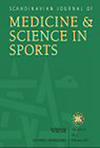Test-Retest Reliability of Running Economy and Other Physiological Parameters During 90 min of Running in Well-Trained Male Endurance Runners.
IF 3.5
2区 医学
Q1 SPORT SCIENCES
引用次数: 0
Abstract
Running economy (RE) is highly reliable when measured in an unfatigued state; however, its reproducibility during prolonged exercise has not been investigated. RE is known to worsen during prolonged exercise (referred to as RE "durability"), and quantifying the reliability of RE durability measurements will determine our sensitivity to detect subtle differences between groups or conditions. This study aimed to assess the reliability of RE and other physiological parameters throughout a 90-min run in the heavy-intensity domain among well-trained runners. Fourteen male marathon runners (maximal oxygen uptake (V̇O2max): 63.1 ± 5.8 mL·kg-1·min-1; marathon time: 02:47 ± 00:10 h:min) completed two 90 min treadmill runs at a speed of 10% Δ between lactate threshold one (LT) and two (LT2) (14.1 ± 0.9 km·h-1). Measurements were taken at 15 min intervals for RE (expressed as energy cost [EC] and oxygen cost [OC]), ventilation (V̇E), heart rate (HR), blood lactate (BLa), and rating of perceived exertion (RPE). Reliability was quantified using intraclass correlation coefficients (ICCs), coefficient of variation (CV), typical error (TE), and systematic differences. Both EC and OC demonstrated excellent reliability (ICCs 0.96-0.99; TEs 0.7%-1.4%; CVs 0.6%-1.2%) consistent across all time points (p > 0.15). V̇E and HR were highly reliable, whereas RPE and BLa exhibited greater variability, such that BLa became less reliable with run duration, especially after 60 min of exercise (time effect on BLa CV: p = 0.01). These results indicate that relatively modest changes in RE durability due to interventions or between conditions are likely to be detected, and provide critical information for future experiments aiming to measure and enhance the durability of endurance athletes.训练有素的男性耐力跑者90分钟跑步经济性及其他生理参数的重测信度。
在非疲劳状态下,运行经济性(RE)具有很高的可靠性;然而,其在长时间运动中的再现性尚未得到研究。众所周知,在长时间的运动中,RE会恶化(称为RE“耐久性”),量化RE耐久性测量的可靠性将决定我们检测群体或条件之间细微差异的灵敏度。本研究旨在评估训练有素的跑步者在90分钟的高强度跑步过程中RE和其他生理参数的可靠性。14名男性马拉松运动员(最大摄氧量(V * O2max): 63.1±5.8 mL·kg-1·min-1;马拉松时间:02:47±00:10 h:min)以10% Δ乳酸门槛1 (LT)和2 (LT2)(14.1±0.9 km·h-1)之间的速度完成两次90分钟的跑步机跑。每隔15分钟测量一次RE(以能量消耗[EC]和氧消耗[OC]表示)、通气量(V (E))、心率(HR)、血乳酸(BLa)和感觉运动等级(RPE)。信度采用类内相关系数(ICCs)、变异系数(CV)、典型误差(TE)和系统差异进行量化。EC和OC均具有良好的信度(ICCs为0.96 ~ 0.99;te 0.7% - -1.4%;CVs(0.6%-1.2%)在所有时间点上一致(p < 0.05)。V (E)和HR具有较高的可靠性,而RPE和BLa表现出较大的变异性,因此BLa随着跑步时间的增加而变得不可靠,特别是在运动60 min后(时间对BLa CV的影响:p = 0.01)。这些结果表明,干预或条件之间的相对适度的变化可能会被检测到,并为未来旨在测量和提高耐力运动员耐久性的实验提供关键信息。
本文章由计算机程序翻译,如有差异,请以英文原文为准。
求助全文
约1分钟内获得全文
求助全文
来源期刊
CiteScore
7.90
自引率
4.90%
发文量
162
审稿时长
3 months
期刊介绍:
The Scandinavian Journal of Medicine & Science in Sports is a multidisciplinary journal published 12 times per year under the auspices of the Scandinavian Foundation of Medicine and Science in Sports.
It aims to publish high quality and impactful articles in the fields of orthopaedics, rehabilitation and sports medicine, exercise physiology and biochemistry, biomechanics and motor control, health and disease relating to sport, exercise and physical activity, as well as on the social and behavioural aspects of sport and exercise.

 求助内容:
求助内容: 应助结果提醒方式:
应助结果提醒方式:


